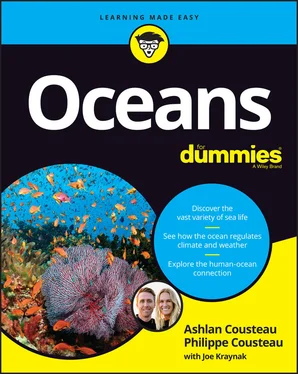Tracing the Evolution of Ocean Life
Although scientists may not be able to pin down where all the ocean water came from, one thing we do know for sure is that life on Earth started in the ocean. In fact, it started not too long after the ocean was formed and has continued evolving ever since. Although the ocean probably existed for at least a few hundred million years before signs of life appeared, that’s not very long from a geological perspective. Because life has existed in the ocean for most of the time that the ocean itself has been around, most of the ocean’s history is commonly presented as a timeline designating key stages in Earth’s geological progression coupled with the corresponding evolution of life. Kind of convenient, isn’t it? In this section, we trace the fascinating progression of that evolution, but first, we need to define a few key terms:
Life is the condition that distinguishes plants and animals (organic) from inorganic matter, such as rocks, minerals, metals, and other substances not derived from living organisms.
Evolution is the process by which species of organisms arise from earlier life-forms and change over time through natural selection.
Natural selection is the process by which organisms better adapted to their environment tend to survive and produce more offspring, while those less adapted tend to die out.
Getting the evolutionary ball rolling
So how did life begin? Well, honestly we still don’t know for sure. One theory is abiogenesis — that life spontaneously arose from non-living material. Another theory, called panspermia, suggests that life came from space on a comet or asteroid. But the leading theory is the RNA World Hypothesis . RNA is similar to DNA but is structured as a single strand as opposed to a double strand and is made up of different nucleobases (the molecular building blocks of RNA and DNA). According to the RNA World Hypothesis, early life on Earth originated with simple RNA molecules that were able to self-replicate (create copies of themselves) and create protein molecules — organic compounds that are an essential part of all living organisms.
Another quality of RNA that makes many scientists believe that RNA drove early evolution is that it has the capacity to evolve through interactions with its environment. The RNA World theory has it that diverse RNA molecules formed (how this happened is still not known) and began to evolve and compete for survival. As they evolved, some RNA molecules began to cooperate with one another to develop genetic code, form proteins, and build cells. Eventually, RNA gave rise to DNA, which has the capacity to store more complex blueprints for living things.
However life started, for it to become more complex, cells were required. (A cell is a membrane-bound entity containing molecules to sustain life.) The first cell is thought to have consisted of a membrane composed of phospholipids surrounding self-replicating RNA. Phospholipids are fatty acids consisting of two hydrophobic (water-fearing) tails and a hydrophilic (water-loving) head that function as the building blocks of all biological membranes. When placed in water, phospholipids naturally aggregate with their heads facing out and tails facing in, forming a two-layer barrier. A cell membrane composed of phospholipids functions like the “skin” of a cell, separating its contents from what’s outside it. In early cells, the membrane functioned as an enclosure for the RNA and other molecules, enabling them to operate as a unit with the capacity to reproduce and evolve.
The first true single-cell organisms to enter the picture were the prokaryotes — bacteria and archaea. The distinguishing characteristic of prokaryotes is that they lack a membrane-bound nucleus (control center), mitochondria (power plant), or other membrane-bound organelles (organized structures within a cell). Early prokaryotes are thought to have been chemoautotrophs — creating their own energy by oxidizing inorganic compounds. Later, approximately 3.5 billion years ago, cyanobacteria evolved, deriving their energy from photosynthesis — using sunlight to synthesize foods from carbon dioxide and water.
Even later, about 1.8 billion years ago, more complex single-cell organisms called eukaryotes appeared. A eukaryote is any organism consisting of one or more cells containing membrane-bound organelles including a distinct nucleus that contains DNA in the form of chromosomes. (You still with us?) Eukaryotes include all living organisms except prokaryotes. In other words, you’re a eukaryote and probably didn’t even know it. However, you do have numerous prokaryotes living on and inside you, most of which are beneficial, and some of which perform essential functions (such as aiding in digestion and synthesizing vitamins your body needs but doesn’t get in its diet or produce on its own).
And now for a word about metabolism
Before moving on to the evolution of more complex organisms, we’d like to give a shout out to energy — the power that sustains life and drives evolution. So where does all this energy come from? It comes from a set of life-sustaining chemical reactions in organisms collectively referred to as metabolism . These chemical reactions can be divided into two types:
Anabolic processes build molecules. When you’re pumping iron at the gym, anabolic processes are at work synthesizing protein molecules to build muscle. Energy is required to fuel anabolic processes.
Catabolic processes break down molecules into smaller units, often releasing energy; for example, your body can break down sugar or fat molecules to give you the energy to pump that iron.
All living things use the stuff around them to obtain the energy and molecules they need to carry out vital cellular processes, to reproduce, and, in some cases, to move around. However, every known ecosystem on Earth is fueled by organisms that rely on one of the following two metabolic mechanisms:
Photosynthesis is the best known of these processes and uses energy from the sun to convert carbon dioxide and water into chemical energy and organic molecules needed for growth. Lucky for us, oxygen is released as a waste product
Chemosynthesis is less well known and uses energy stored in the chemical bonds of inorganic chemicals such as hydrogen sulfide and methane to make glucose from carbon dioxide and water. Chemosynthesis is what enables bacteria to live near hydrothermal vents at the bottom of the deep blue sea. (See Chapter 5for more about life that exists around hydrothermal vents.)
 Organisms that rely on chemosynthesis and photosynthesis anchor the food webs that enable ecosystems to develop. They’re sort of like the farmers who grow all the food, except they are the food!
Organisms that rely on chemosynthesis and photosynthesis anchor the food webs that enable ecosystems to develop. They’re sort of like the farmers who grow all the food, except they are the food!
All together now: Multicellular organisms
Over time, cells began to gather and hang out together, probably not out of loneliness but because sticking together was advantageous to each cell in the group. It’s sort of like schools of fish forming to ward off predators or the way some plants and animals form symbiotic relationships; for example, a sea anemone’s tentacles protect a clownfish from predators while the clownfish chases away butterfly fish that would eat the anemone. Of course, symbiosis is different at the cellular level, but the concept is the same.
For whatever reason, cells began to aggregate forming filaments or mats consisting of the same cell types (colonies) or different cell types (symbiosis). Over time, cells formed clumps and then the clumps formed more and more intricate structures with different parts of each structure performing a distinct function; for example, cells at one end of the structure could be in charge of consuming nutrients, while cells at the other end could be in charge of eliminating waste products.
Читать дальше

 Organisms that rely on chemosynthesis and photosynthesis anchor the food webs that enable ecosystems to develop. They’re sort of like the farmers who grow all the food, except they are the food!
Organisms that rely on chemosynthesis and photosynthesis anchor the food webs that enable ecosystems to develop. They’re sort of like the farmers who grow all the food, except they are the food!










